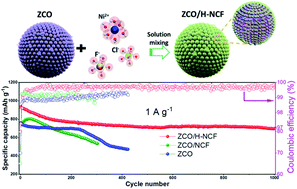Highly reversible lithium storage in a conversion-type ZnCo2O4 anode promoted by NiCl2−xFx hydrate†
Abstract
Transition metal oxides are important conversion-type anodes in lithium ion batteries because of their low cost and high specific capacity. However, the poor conversion-reaction reversibility leads to low coulombic efficiency, sluggish reaction kinetics and unsatisfactory long-term cycling stability, thus severely hindering their practical applications. In this research, we propose a facile strategy to achieve highly reversible lithium storage in a ZnCo2O4 anode by coating ultrafine NiCl2−xFx hydrate on porous ZnCo2O4 microspheres. The intimate and well-distributed contact between two components significantly enhances the activity of the reversible conversion reaction. The NiCl2−xFx hydrate also promotes the reversible decomposition of organic components in the as-formed solid electrolyte interface, evidenced from several microstructural analyses. Moreover, the ultrafine hydrated NiCl2−xFx effectively pins ZnCo2O4 to inhibit the detrimental grain coarsening process during cycling. As a result, the hybrid anode shows significantly increased initial coulombic efficiency from 69.1% to 83%, and the round-trip energy efficiency from 50% to 58.7%. It also demonstrates excellent rate capability and superior cycling stability.



 Please wait while we load your content...
Please wait while we load your content...